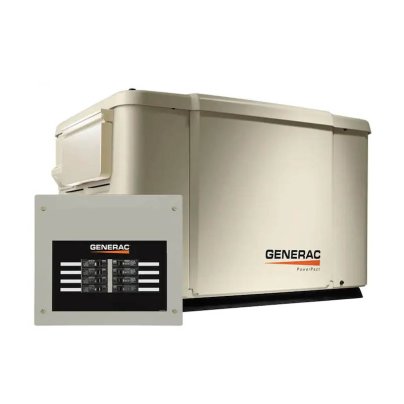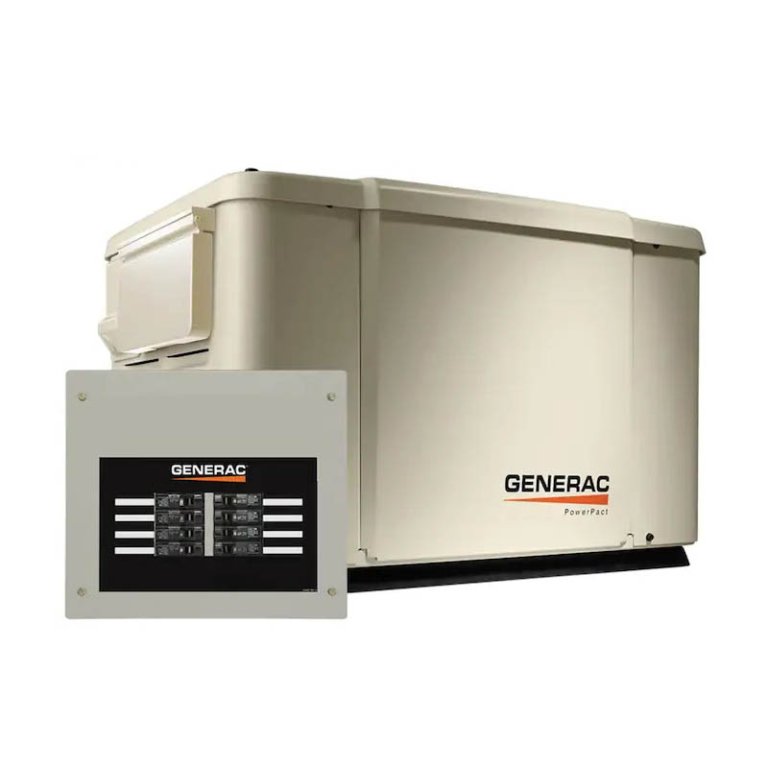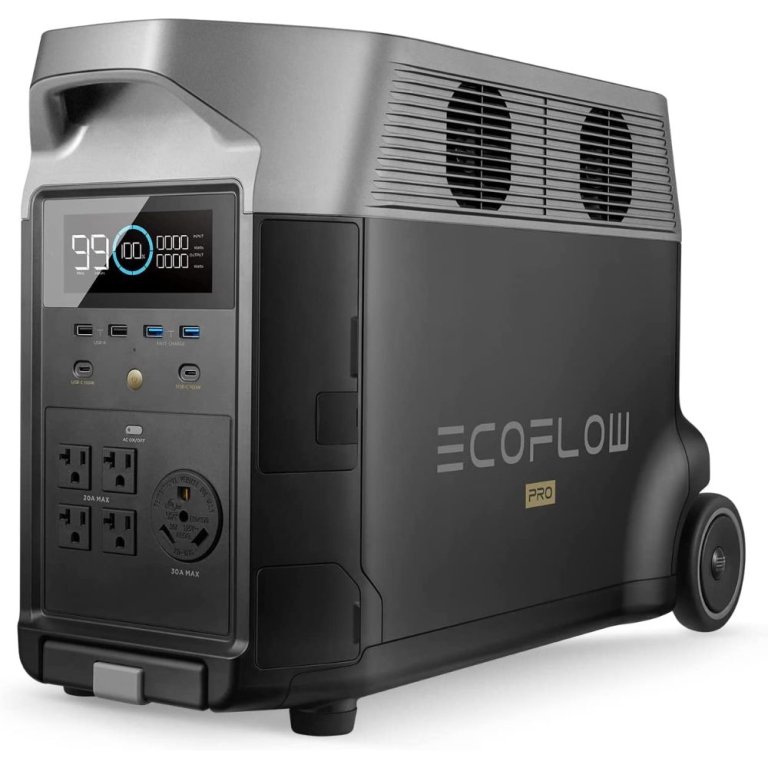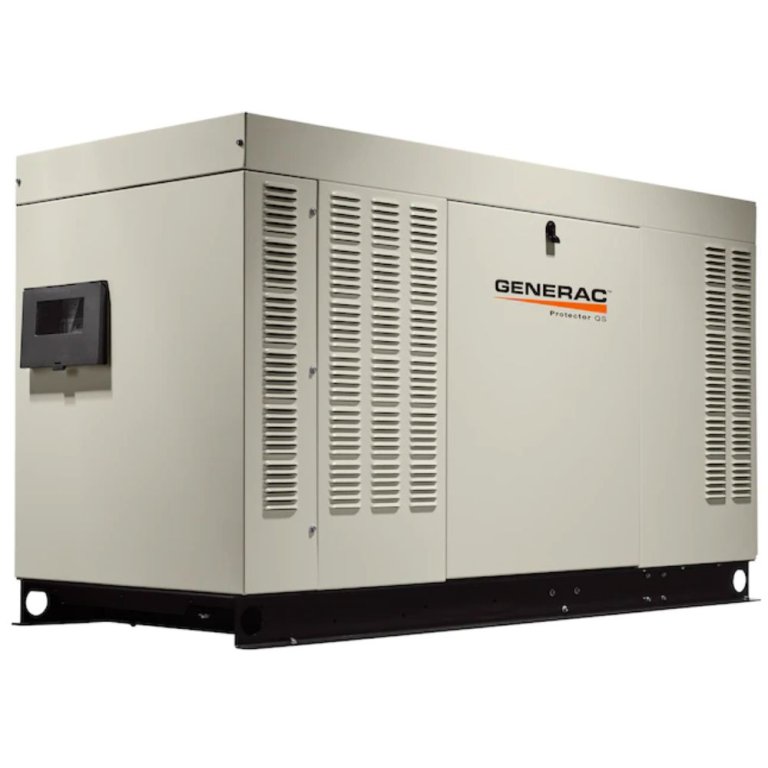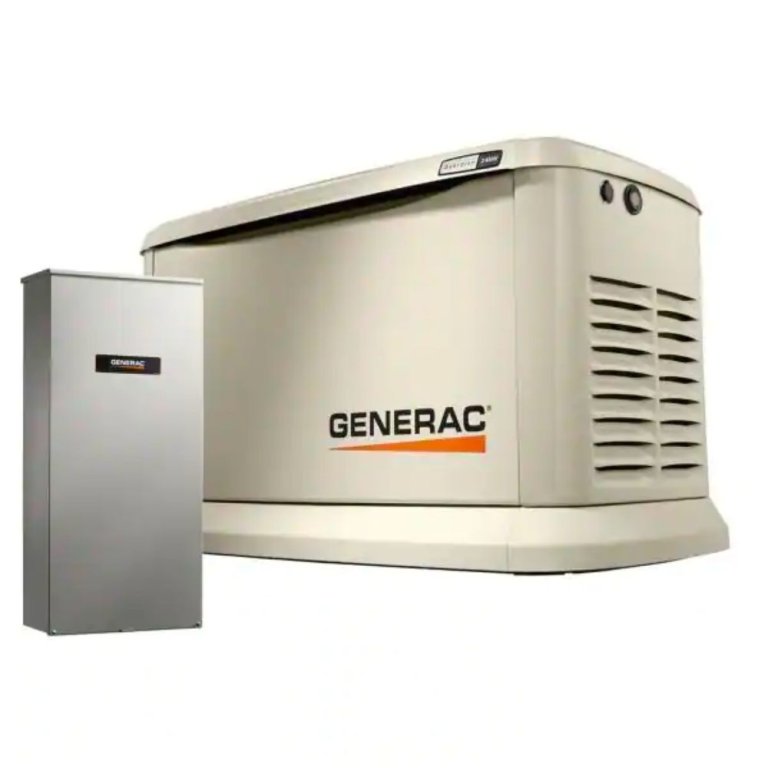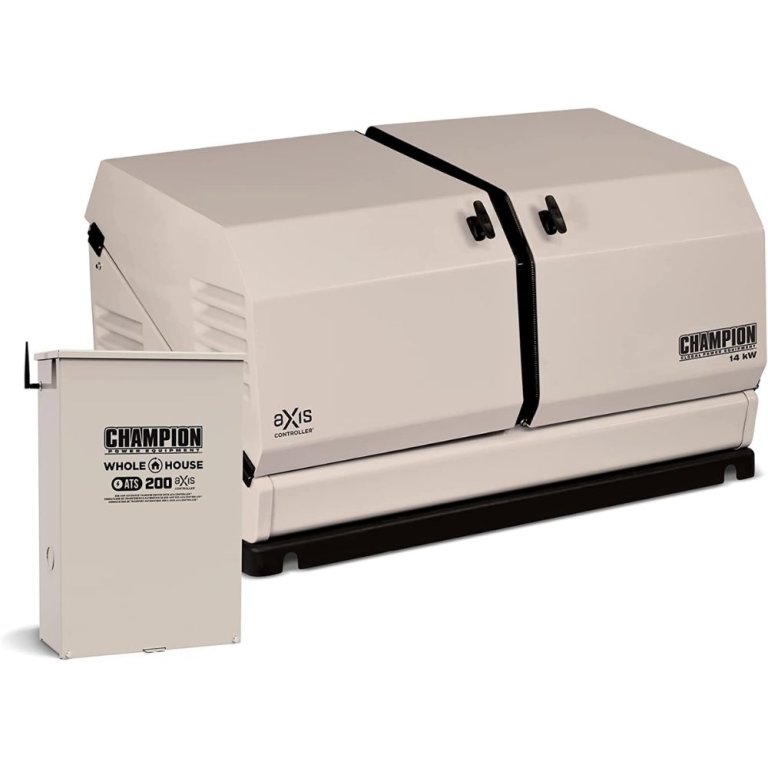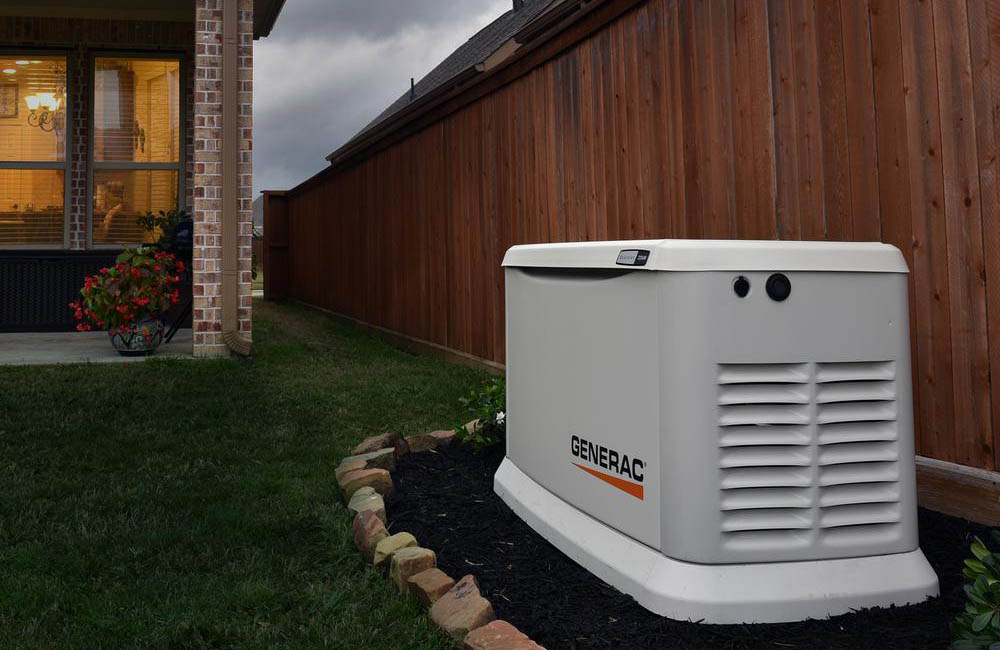
We may earn revenue from the products available on this page and participate in affiliate programs. Learn More ›
The purpose of a generator is to provide power to appliances, electronic devices, and lighting in remote locations, like campsites or an RV. But when the power goes out at home, a portable generator won’t have the necessary output to supply the entire house. If power outages are a regular occurrence or a significant concern for you and your family, consider investing in a standby generator.
These large devices become semipermanent fixtures in your home with a line that runs directly to the electrical system. This ensures that when the power goes out, the standby generator will automatically start and get the power back on within minutes. The list of products below highlights some of the top options available, and it’s a great place to start the search for the best standby generator for backup power at home.
- BEST OVERALL: Generac Guardian Home Backup Generator
- RUNNER-UP: Briggs & Stratton PowerProtect Standby Generator
- BEST BANG FOR THE BUCK: Generac PowerPact Home Backup Generator
- BEST DUAL FUEL: Kohler Standby Generator w/ Automatic Transfer Switch
- BEST FOR SMALL HOMES: EcoFlow Delta Pro Portable Power Station
- BEST FOR LARGE HOMES: Generac Protector QS Automatic Standby Generator
- BEST MONITORING: Generac Guardian Backup Generator With Mobile Link
- BEST FOR WARM CLIMATES: Generac Protector QS Premium-Grade Standby Generator
- BEST FOR COLD WEATHER: Champion aXis Home Standby Generator
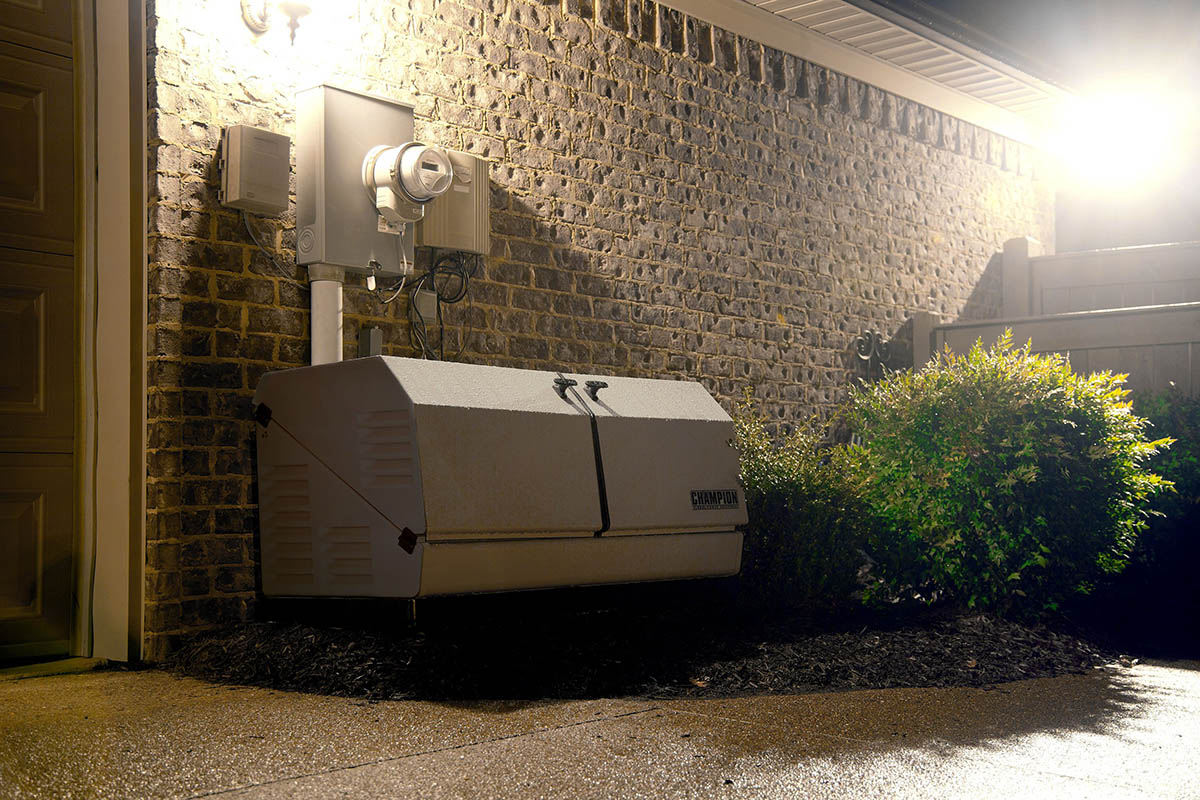
How We Chose the Best Standby Generators
Trying to choose the best whole-house generator from the wide range of available products isn’t an easy task. We conducted extensive research into over 30 generators to assemble this list of the top standby generators for your home. The key factors we considered during the selection process included wattage, fuel source, transfer switch, and physical dimensions.
We chose low-wattage and high-wattage generators for this list to accommodate the power needs of both smaller and larger homes. Similarly, we gave preference to dual-fuel generators because having a generator that can run on more than one type of fuel in an emergency is always better.
Typically, standby generators either come with a transfer switch or need one installed to transfer power to the home. Generators with automatic transfer switches make this process easier than relying on the user to switch the power manually. Standby generators with special features, like wireless monitoring or a liquid-cooled cooling system, were considered superior to similar products that lacked these features.
Our Top Picks
This list of top products was selected based on the important criteria mentioned above. Each considers power needs and type, fuel source, installation requirement, transfer switch features, and overall quality to help you find the best standby generator. Read on to learn how to keep the lights on when the power goes out.
Best Overall
Generac Guardian Home Backup Generator
Pros
- Dual-fuel unit allows for added flexibility during an outage
- WiFi-enabled unit for wireless monitoring; easier for users to track
- System status and maintenance LED indicators are easy to read
Cons
- Extreme temperatures such as snowstorms may cause the filter to freeze
Product Specs
- Fuel source: Liquid propane and natural gas
- Running watts: 22,000 watts (propane) or 19,500 watts (natural gas)
- Dimensions: 48 inches long by 25 inches wide by 29 inches high
Generac is known for producing a wide range of quality standby generators, and the Generac Guardian standby generator blends affordability, substantial power, and an automatic transfer switch to provide you with a reliable product that meets most needs. While a majority of homes only needs 5,000 watts for essential appliances, this standby generator can produce up to 22,000 running watts, ensuring that the whole home has power, not just the essentials.
The standby generator is a dual-fuel product that can operate on both liquid propane (22,000 running watts) and natural gas (19,500 running watts). It can also connect remotely through Wi-Fi, so you can get regular updates on the status of the system. The generator also has exterior system-status lights to keep you informed of maintenance needs.
Get the Generac Guardian home backup generator at Amazon, Lowe’s, The Home Depot, Acme Tools, or Northern Tool + Equipment.
Runner-Up
Briggs & Stratton PowerProtect Standby Generator
Pros
- Wireless monitoring provided through InfoHub, so you don’t need to be near the unit to check its status
- Relatively quiet operation at just 68 decibels under normal operation
- Low-oil detection system triggers automatic shutdown; helps keep the unit running smoothly
Cons
- Air-cooled system may struggle to keep temperatures down in hot climates
Product Specs
- Fuel source: Liquid propane and natural gas
- Running watts: 20,000 watts (propane) or 20,000 watts (natural gas)
- Dimensions: 46.5 inches long by 26.8 inches wide by 28.4 inches high
The best standby generators, like this model by Briggs & Stratton, come equipped with an automatic transfer switch so that when the power fails, the generator automatically starts. You can take advantage of the WiFi-equipped whole-house generator for remote monitoring through the InfoHub app. The app even sends maintenance alerts to help ensure that you’re on top of maintenance tasks and that the generator is functioning properly.
This generator includes a low-oil detection system that will shut down the generator to prevent overheating and ongoing damage to the internal mechanisms. It uses either liquid propane or natural gas for convenience in emergencies, and the generator has a maximum wattage of 20,000 watts, regardless of which fuel it’s using. It should also be mentioned that the generator uses an air-cooled system that is effective in most climates, though it may not be able to keep up with cooling demands in warmer locations.
Get the Briggs & Stratton standby generator at Lowe’s, Electric Generators Direct, or eComfort.
Best Bang for the Buck
Generac PowerPact Home Backup Generator
Pros
- Affordable generator for powering essential systems in emergencies
- Digital controller with LED status indicators is easy to read and use
- Equipped with an automatic transfer switch, allowing for smoother operation
Cons
- Relatively low wattage may not be enough for larger households or all appliances
Product Specs
- Fuel source: Liquid propane and natural gas
- Running watts: 7,500 watts (propane) or 6,000 watts (natural gas)
- Dimensions: 36 inches long by 27 inches wide by 25 inches high
Keep a backup system ready to support the essential appliances in your home when the power goes out with this Generac PowerPact standby generator. The PowerPact comes with a digital controller with LED indicators for monitoring the generator status, utility power presence, and maintenance needs. It has a galvanized steel enclosure that protects against rain and sleet and includes an all-weather composite mounting pad that resists corrosion.
Connect either the home propane or natural gas system to the standby generator and get up to 7,500 watts of power on propane and 6,000 watts on natural gas, ensuring that the essential appliances can still run in emergencies. At this lower wattage, however, unnecessary systems, like televisions, may not be able to be used. The PowerPact comes with an automatic transfer switch to monitor the home’s power. It automatically starts when a power outage is detected—though it can only power up to eight circuits due to the low wattage.
Get the Generac PowerPact standby generator at Lowe’s, The Home Depot, Northern Tool + Equipment, or Electric Generators Direct.
Best Dual Fuel
Kohler Standby Generator w/ Automatic Transfer Switch
Pros
- Includes dual fuel capability; flexible choice of liquid propane or natural gas
- Automatic transfer switch will turn on the power during an outage
- Impressive wattage; can handle most home appliances
Cons
- Overall size of this generator is quite larger than other options
Product Specs
- Fuel source: Liquid propane or natural gas
- Running watts: 14,000 (LP), or 12,000 (NG)
- Dimensions: 47 inches long by 26.2 inches wide by 32.2 inches high
The Kohler Standby Generator is a reliable backup power solution for shoppers looking to keep the lights on in a pinch. Engineered to deliver exceptional performance, this generator ensures your peace of mind during power outages. Equipped with an automatic transfer switch, it seamlessly activates within seconds, automatically providing uninterrupted power to your home or business.
Designed for versatility, the Kohler generator offers fuel flexibility, capable of running on either liquid propane or natural gas. This allows you to choose the option that suits your needs and availability. With a robust 14k-watt capacity using liquid propane, or 12k-watt on natural gas, this generator has ample power to support essential appliances and electronics, ensuring your comfort and security are maintained even during prolonged blackouts.
Crafted with Kohler’s renowned durability and reliability, this standby generator is built to last. Its advanced features, combined with a user-friendly interface, make it easy to operate and monitor.
Get the Kohler standby generator at Lowe’s, The Home Depot, Menard’s, Nationwide Generators, or Brags + Hayes.
Best For Small Homes
EcoFlow Delta Pro Portable Power Station
Pros
- This power station is a compact size and includes 2 wheels and a handle for added portability
- Allows multiple charging methods, with solar being ideal for extended outages
- Can be upgraded and paired with multiple units for additional power output
Cons
- Lower wattage output compared to conventional generators
- Unit must be charged for use, requiring users to be prepared in advance
Product Specs
- Fuel source: Electric
- Running watts: 3,600 watts
- Dimensions: 25 inches long by 11.2 inches wide by 16.4 inches high
While not precisely a full-fledged standby generator, this portable power station from EcoFlow may do the trick for smaller households. Its attractive price point may also be an ideal option for shoppers looking to have backup power without making a major investment in a larger standby generator. Unlike fuel generators, this home battery runs silently, so there are no loud noises or fumes to worry about. At a modest 3,600-watt AC output, this is certainly not the punchiest generator on our list. However, note that the EcoFlow can be expanded to pair several units together to achieve up to 25,000 watts of power—more than enough to power most heavy-duty devices.
This backup power kit comes with the compact unit, a transfer switch, and a power cord. Should the home lose power, simply plug in devices and keep the lights on during the outage. When not in use, the EcoFlow can be charged via multiple charging methods, including AC, car charge ports, and solar, which can be a lifeline during extended outages with limited fuel availability.
Get the EcoFlow standby generator at Amazon, Lowe’s, The Home Depot, B&H, REI, Cabela’s, or EcoFlow.
Best For Large Homes
Generac Protector QS Automatic Standby Generator
Pros
- High wattage can easily supply power for the whole home during an outage
- Like most high-end units, it is Wi-Fi enabled for wireless monitoring
- Corrosion-resistant and durable construction designed for salty air conditions
Cons
- Large size takes up a lot of yard space; can be an eyesore in smaller areas
Product Specs
- Fuel source: Liquid propane and natural gas
- Running watts: 38,000 watts (propane) or 38,000 watts (natural gas)
- Dimensions: 76.8 inches long by 35 inches wide by 46.1 inches high
When a portable generator falls short of the power output necessary, the next step is to look for a whole-house generator that can provide substantial electricity during a power outage. Whether it’s needed to power a small commercial location or a large home, this Generac standby generator is an excellent option that can generate up to 38,000 running watts. Fuel the generator with liquid propane or natural gas, but make sure there is enough space for the bulky size, which measures 76.8 inches long by 35 inches wide by 46.1 inches high.
An aluminum corrosion-resistant enclosure protects the entire unit from water and salty sea air. This WiFi-enabled generator allows you to wirelessly monitor the unit’s current status and keep up with scheduled maintenance tasks to ensure the generator works without a problem in an emergency. Just keep in mind that this unit’s high power output comes at a fairly high price.
Get the Generac Protector automatic standby generator at Blain’s Farm & Fleet, Grainger, Electric Generators Direct, or eComfort.
Best for Monitoring
Generac Guardian Backup Generator With Mobile Link
Pros
- Multilingual LCD display provides monitoring data for a wide range of people
- Equipped with an automatic transfer switch for easier operation
- Generac is a highly respected and reliable brand for standby generators
Cons
- Installation can be complicated depending on the area you live in; professional help is recommended
Product Specs
- Fuel source: Liquid propane and natural gas
- Running watts: 24,000 watts (propane) or 21,000 watts (natural gas)
- Dimensions: 48 inches long by 25 inches wide by 29 inches high
In order to keep a close eye on the generator’s status without needing to walk out to the yard multiple times a day, Generac has designed this Guardian generator to communicate wirelessly with the Mobile Link app. You can quickly check on the generator using a smartphone, tablet, or computer if the device has access to an active internet connection. The generator also has an onboard multilingual LCD display in case the power outage affects the internet.
This standby generator produces up to 24,000 running watts with liquid propane or up to 21,000 running watts with natural gas so that you can feel confident about your operational options in an emergency. It’s also equipped with an automatic transfer switch, allowing the generator to detect when the power to the home goes out and automatically activate to provide power. However, this generator is air-cooled, which means it may be unable to keep cool in warmer climates.
Get the Generac Guardian standby generator with Mobile Link at Amazon, Lowe’s, The Home Depot, Tractor Supply Co., Northern Tool + Equipment, or Supply Works.
Best for Warmer Climates
Generac Protector QS Premium-Grade Standby Generator
Pros
- This unit’s liquid-cooled system prevents overheating in hot locations
- Produces ample power output suitable for handling most house sizes
- Aluminum enclosure is resistant to rusting and corrosion; great longevity
Cons
- This generator is very large and takes up a sizable portion of the yard
Product Specs
- Fuel source: Liquid propane and natural gas
- Running watts: 32,000 watts (propane) or 32,000 watts (natural gas)
- Dimensions: 76.8 inches long by 35 inches wide by 46 inches high
Capable of generating enough power for the entire home, this dual-fuel generator is a great choice for emergencies, and it’s designed with a liquid-cooled system that helps to prevent overheating in warmer climates. The aluminum enclosure has a powder-coated finish intended to resist rusting and corrosion, which is common in seaside communities due to the salt and moisture in the air.
Monitor the standby generator with the onboard LCD display or simply check the status of the unit wirelessly through the Mobile Link app. Just make sure to measure the yard and compare these measurements to the dimensions of the generator before deciding that this unit is the best option for your home. While it can produce up to 32,000 running watts with either liquid propane or natural gas, the generator takes up a lot of space and comes at a high price.
Get the Generac Protector QS Premium-Grade standby generator at Northern Tool + Equipment, Blain’s Farm & Fleet, Grainger, Electric Generators Direct, or eComfort.
Best for Cold Weather
Champion aXis Home Standby Generator
Pros
- Operates in extreme hot or cold temperatures, so it’s ideal for any climate
- Automatic start and shut-off capabilities help users save on fuel
- Unit is relatively compact, and installation is fairly simple with good instructions
Cons
- Some reports of stalling on start-up; may require regular maintenance
Product Specs
- Fuel source: Natural gas and liquid propane
- Running watts: 14,000 watts (propane) or 12,500 watts (natural gas)
- Dimensions: 49 inches long by 28 inches wide by 28 inches high
The Champion aXis pumps out an impressive 14,000 watts of power and operates using a fully automatic system to manage regular household power loads even in extremely cold temperatures. This is an ideal purchase for shoppers in cooler climates looking to invest in a backup power system during an outage.
This versatile system can run on either natural gas or liquid propane and will start automatically when household power goes out. It also turns itself off once regular power is restored so that it won’t waste any fuel by overlapping power coverage. This durable unit is built to operate within temperatures from -22 to 104 degrees Fahrenheit.
Get the Champion standby generator at Amazon, The Home Depot, Tractor Supply Co., Acme Tools, Cabela’s, or Nationwide Generators.
Jump to Our Top Picks
What to Consider When Choosing a Standby Generator
Don’t rush the decision when figuring out which standby generator would be the best for your home. Take some time to consider important features like your home’s power needs, the generator’s size in power output, and what type of fuel source would be the most suitable. With a better understanding of these features, you will be prepared to decide on the best standby generator for backup power.
Power Needs and Size
When deciding on the best standby generator to provide power to your home, first consider the home’s power needs. Check the wattage on essential appliances, like the fridge, stove, freezer, and furnace. Add the wattage of all essential appliances together to find the total wattage necessary to run the home. A home’s typical minimum wattage needs generally fall between 5,000 and 7,500 watts, though finding a generator that can provide more than the minimum is advised.
The size of a generator refers to the electrical output—not physical size. Standby generators range from as low as 7,500 watts for small homes to over 50,000 watts for large homes, though most fall between 20,000 watts and 30,000 watts. The starting watts level refers to the electrical output when the generator first turns on. It’s usually about 2,000 watts higher than the running watts output, which is the rating given to the continuous electrical output the generator operates at.
Always use the running watts rating when deciding on the best standby generator for your appliances because the starting watts rating isn’t a reliable measurement of the generator’s capabilities.
Fuel Source
There are several options to choose from when trying to figure out the best fuel source for a standby generator, including natural gas, liquid propane, diesel, and dual-fuel options.
- Natural gas (NG) is a relatively common fuel source for standby generators. The semipermanent installation of these large devices prompts some users to connect the generator directly to their natural gas line so they never need to worry about refueling the generator. However, natural gas is the least efficient fuel source available, though these generators make up for the inefficiency with a comparatively clean exhaust output.
- Liquid propane (LP) as a fuel source is the most commonly used option for standby generators. Propane is a clean-burning fuel that’s more efficient than natural gas, and generators that run on propane can either be tied into the home’s primary propane tank or have a separate tank specifically for the generator.
- Diesel is a highly efficient fuel source that provides more power per gallon than both natural gas and liquid propane. However, diesel generators can be difficult to find. They also produce harmful exhaust fumes that may be a problem in a residential neighborhood depending on the yard’s size, neighbors’ proximity, and the presence of kids or pets.
- Dual fuel is a feature many standby generator manufacturers offer. It allows the generator to function with either natural gas or liquid propane. Products with this option are a more versatile choice for users who aren’t sure which fuel is best.
Transfer Switch
A transfer switch connects the generator to the home’s main electrical panel, allowing you to switch or transfer between the utility’s power grid and the power produced by the generator. Some products have an automatic transfer switch that will monitor the incoming power to the house and automatically switch to generator power when it detects a power outage. This process typically takes about 30 seconds to 1 minute and ensures the home is never without electricity.
Automatic transfer switches are a necessary feature to protect the home when you’re not around. Another great feature is remote monitoring, which allows you to connect to the generator through Wi-Fi to get updates on the generator’s function. This service notifies you when the generator kicks on to provide continuous power or if it is just turning on for a few minutes to recharge the starting battery. Remote monitoring lets you relax, knowing your home is protected from power outages.
Additional Features
Standby generator manufacturers have added various features to make their products more appealing and functional for users, including automatic starts, remote-start systems, system status lights, and corrosion-resistant enclosures.
- Automatic-start systems monitor the home’s electrical system, and if the power goes out, the system detects the outage, automatically starting the generator within about 1 minute. These systems also regularly run exercise cycles to keep the starting batteries charged.
- Remote-start systems can be a push button, switch, or remote control that starts the standby generator without the user going to the transfer switch. Sometimes generators even offer remote start through mobile devices via compatible apps using Wi-Fi connectivity.
- System status lights alert you to the need for maintenance, so you only need to look at the generator to stay updated on the current status.
- Corrosion-resistant enclosures are typically made of a composite material or aluminum. These materials prevent rusting, corrosion, and damage from rain, sleet, high humidity, and salt, protecting the generator from harsh weather or ocean spray in coastal cities.
Installation
Installing a standby generator is significantly more involved than running a portable generator, so manufacturers often provide detailed installation instructions. Some companies may even offer prepackaged and prewired systems to help make the installation process easier. However, evaluating your knowledge before deciding to take on this project yourself is important. Are you comfortable connecting the generator directly to the home’s electrical system? Do you need to expand the gas line? Have you received the proper permits for installing a standby generator according to the local and state code?
If any of these tasks seem outside of your skill set, hiring a professional electrician to connect the wiring and a plumber or gas fitter to connect a natural gas or propane gas line to the home supply is advised. These professionals will know which permits you need, and they will have the experience necessary to install a standby generator. Proper installation helps ensure the generator is truly reliable in emergencies.
FAQs
Even after deciding on the best standby generator for your home, these complex machines can leave new users with a host of questions. Look below for answers to some of the most commonly asked questions about standby generators to feel confident in your decision.
Q. What’s the difference between portable and standby generators?
There are many differences between portable and standby generators. Portable generators are movable, while standby generators are stationary. Standby generators also output a much higher amount of electricity than portable generators, making them suitable for a whole home instead of only powering a camper. In appearance, portable generators are open with exposed engine parts, while standby generators are fully enclosed. Another feature of standby generators that sets them apart from portable generators is the automatic-start function that detects a power outage and automatically starts the generator within about 1 minute.
Q. How do I correctly size a generator for my home?
In order to determine the correct size of a standby generator for your home, find the wattage of the appliances in the home, like the fridge, stove, furnace, and freezer. Add these numbers to find the necessary wattage to run the home, then look for a generator that can supply the house with more than enough electricity. Typically, the essential appliances in a home will use about 5,000 watts, so this should be the minimum size for a standby generator.
Q. How long can a standby generator run continuously?
The runtime varies with the size, appliance load, and fuel type, but typically a liquid propane generator with a 100-gallon tank will run for about 50 hours, while a 250-gallon tank runs for about 125 hours.
Q. Can an automatic standby generator replace the utility service?
No, an automatic standby generator is a poor replacement for standard utility service because the fuel costs greatly exceed the cost of electricity from the utility company.
Q. Can I install the generator myself?
It depends on your level of proficiency with electrical systems, fuel systems, and residential permits. While some manufacturers offer prepackaged and prewired systems with installation guides, it may be better to employ a professional electrician to connect the generator to your home, and consider using a plumber or gas fitter to connect a natural gas line. These professionals handle this type of work regularly, so there is less chance of a detrimental mistake that could leave you without power when expecting the backup.
Q. Does the generator have to be maintained?
Standby generators do need to be regularly maintained, including routine oil changes, replacing air filters, and semi-regular periods of operation to allow the generator to charge the starting battery.
Q. What’s the advantage of an aluminum or composite generator enclosure?
Using aluminum or composite enclosures on a standby generator helps protect the unit from rust and corrosion. These materials are also resistant to salty air and humid conditions, making them a good option for harsh climates and coastal areas.


